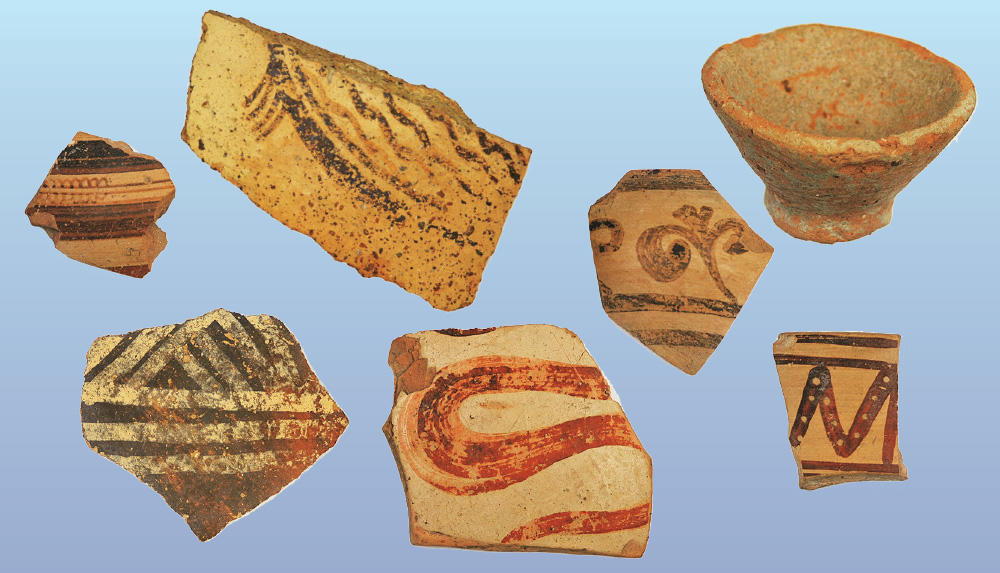In 2015, Senta German ’99GSAS, a scholar of the Aegean Bronze Age (the period of the pre-Greek civilizations of the Mediterranean, circa 3,000 BC to 1,000 BC), organized a conference at the University of Oxford. German was serving as a teaching curator at Oxford’s Ashmolean Museum as part of a Mellon Foundation program to restore the role of artifacts as tools of instruction. Among the speakers at German’s symposium was Roberto C. Ferrari, Columbia’s curator of Art Properties. That’s how German learned about the sherds.
A sherd, short for “potsherd,” is a ceramic fragment, and Ferrari told German that a cache of some seven hundred Aegean sherds were packed away in a storage vault in Avery Hall. About half the sherds dated from the Bronze Age, and Ferrari, knowing this was German’s specialty, asked her if she would examine these ancient pieces and help Art Properties catalog them.
German began the project in 2016. The sherds had been collected by Clarence Ho man Young 1888CC, 1891GSAS, who entered graduate school at a time of feverous excitement around archaeology. “For centuries, historians had been scrambling over above-ground classical monuments. It was only in the 1860s, with the advent of the fi eld of archaeology, that they began digging,” German explains. In the 1870s, while Young was a boy in Manhattan, the German archaeologist Heinrich Schliemann found, in Turkey, the ruins of what he claimed was the city of Troy, site of the Trojan War, as described in Homer’s Iliad. “Until then, no one thought Homer was based on actual history,” German says.
At Columbia, Young, electrified by these events, sought out Augustus Merriam, a professor of Greek literature and the first US scholar to devote himself to classical archaeology. In Butler Library’s Rare Book and Manuscript Library, German unearthed correspondence between Young and Merriam from the early 1890s. The letters revealed an eager grad student who idolized his teacher and a dynamic archaeologist in need of an assistant. “Merriam sent Young to Greece to take photographs of objects and to make impressions of inscriptions, and that’s how Young learned,” says German. Young also joined two digs on Crete, and German believes that some of the sherds came from that trip.
Merriam died in 1895, and it was Young, then an instructor in Greek at Columbia, who, German says, “took up the mantle of the guy who’s not just reading Plato but looking at objects.” Young became a professor of Greek in 1905 and of Greek archaeology in 1919. In letters to President Nicholas Murray Butler, Young asked, and received, permission to return to the Mediterranean to collect materials for his students. “He wanted to have a drawer of sherds in his office — a tradition at Oxford and Cambridge,” says German. “Then, while teaching, he could say, ‘Hold on, let me show you.’”
Young retired in 1937. By then, the sherds were in Schermerhorn Hall, in offices and storage cases. At some point they faded from view. The pieces resurfaced in 2005, when students cleaned and numbered them. By the time German got to them, they were in boxes in Avery. German photographed the sherds, measured them, noted their thicknesses, and identified their decorative motifs and the parts of the vessel they came from. A century after their excavation, Young’s Bronze Age sherds are now cataloged and available for research.
Young never became a renowned archaeologist like his hero Merriam. He settled into the role of educator and administrator, a Columbia lifer who attended football games and oversaw entrance exams in Greek and Latin for Columbia College. He died in 1957 at age ninety. In the archives, German found an autobiographical article by Young that suggested a self-written obituary. In it, Young emphasized the importance of teaching.
“That’s where he saw his value and importance,” German says. “These objects are a part of that legacy — bringing the ancient world to life.”



